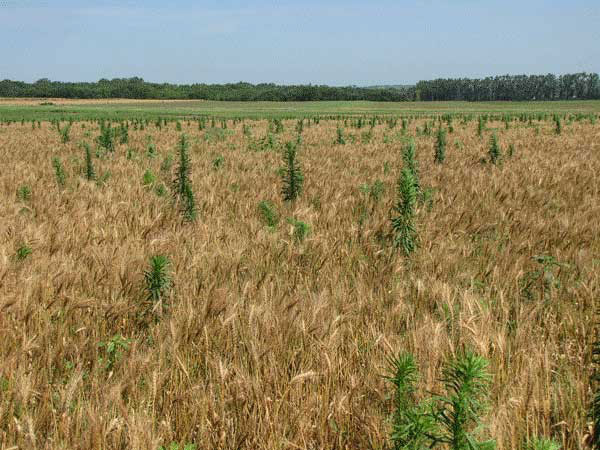Making a herbicide application that will not directly influence crop yield is a difficult decision to make. However, pre-harvest applications may be beneficial, especially in wheat fields that were not treated earlier in the season. When broadleaf weeds grow rapidly in wheat fields at the end of the growing season, several potential concerns arise such as harvest difficulties, dockage problems, weed seed production, and soil water depletion. A pre-harvest herbicide application can address these concerns. However, it is very difficult to estimate the value of pre-harvest weed treatments as it is influenced by the effects on harvest efficiency and dockage. It may not pay to treat wheat with lower weed densities unless harvest is delayed. If the weeds are about to set seed, a pre-harvest treatment can go a long way toward reducing weed problems in future years by preventing seed production.
Herbicides labeled for use as harvest aids in wheat are listed in Table 1. There are differences in how quickly they act to control the weeds, the interval requirement between application and grain harvest, and the level or length of control achieved. All of them will require thorough spray coverage to be most effective. Paraquat is sometimes mentioned as a possible herbicide for pre-harvest application but is not labeled for pre-harvest treatment in wheat. Application of paraquat to wheat is an illegal treatment and can result in a quarantine and destruction of the harvested grain, along with severe fines.

Figure 1. Weeds in wheat near harvest time. Photo by Dallas Peterson, K-State Research and Extension.
Table 1. Herbicides for use a pre-harvest weed control options in wheat.
|
Product (rate) |
Weeds controlled |
Application timing |
PHI* (days) |
Comments |
|
Metsulfuron (0.1 oz + 0.25 to 0.5 % v/v nonionic surfactant)
|
Some broadleaf weeds |
Hard dough stage
|
10
|
Apply in combination with glyphosate or 2,4-D Do not use on soils with a pH greater than 7.9 12- to 34-month rotation interval for soybeans Kochia, pigweeds, and marestail may be resistant |
|
2,4-D LVE |
Broadleaf weeds. |
Hard dough stage |
14 |
Weak on kochia and wild buckwheat |
|
Dicamba |
Broadleaf weeds |
Hard dough stage and green color is gone from nodes |
7 |
Do not use treated wheat for seed unless a germination test results in 95% or greater seed germination. |
|
Glyphosate |
Grasses and broadleaf weeds |
Hard dough stage (30% or less grain moisture).
|
7 |
Consult label for recommended adjuvants Not recommended for wheat being harvested for use as seed |
|
Aim EC |
Pigweeds, kochia, lambsquarters, Russian thistle, wild buckwheat |
|
7 |
Acts quickly, usually within 3 days Regrowth of weeds may occur after 2-3 weeks or more, depending on the rate used. |
|
Sharpen |
Broadleaf weeds
|
Hard dough stage (30% or less grain moisture).
|
3 |
1 month rotation interval for soybean |
*PHI = Pre-harvest interval, or days required between application and harvest.
Sarah Lancaster, Weed Management Specialist
slancaster@ksu.edu
The use of trade names is for clarity to readers and does not imply endorsement of a particular product, nor does exclusion imply non-approval. Always consult the herbicide label for the most current use requirements. For more information, see 2021 Chemical Weed Control for Field Crops, Pastures, Rangeland, and Noncropland, K-State publication SRP-1162.